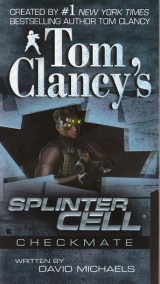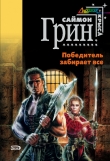
Текст книги "Checkmate (2006)"
Автор книги: David Michaels
Жанр:
Боевики
сообщить о нарушении
Текущая страница: 9 (всего у книги 21 страниц)
“Where does this leave us?” Fisher asked.
“Same place, just a tighter deadline. If there’s something more to all this, we’re running out ot time to find it. But wherever the evidence leads, we have to have all of it. Grim, are you on?”
“I’m here. Sam, two items of interest: One, the data you pulled from the Duroc’s helm console was heavily encrypted—another Marcus Greenhorn masterpiece, but so far it looks like other than the trip from its home port in Port St. Lucie to the Bahamas, it had been up and down the Atlantic Coast, following the deep-sea fishing lanes with a couple stops in Savannah, Hilton Head, Charleston—places like that.
“The stomping grounds of the yacht-owning rich and famous,” Fisher said.
“You got it. I’m still working on an owner, but whoever the Durocbelongs to, they’re wealthy. Item number two: We’ve traced the serial numbers you took from the Trego’s engines. According to Lloyd’s of London, the engines were installed two years ago aboard a freighter named Sogonat Kolobane Shipyard in Dakar, Senegal.”
“Nassiri claims he boarded the Tregooff the coast of Mauritania,” Fisher said. “Dakar’s only a hundred miles from the border.”
“And I’ll give you ten to one the Sogonand Tregoare one in the same,” Lambert said.
“Either that, or it was a swap. Do we know where the Sogonis now?”
Grimsdottir said, “I’m looking. As for the shipyard: I’ve tried to hack into their computer system, but it’s rudimentary at best—e-mail and little more. All records are likely kept as hard copies in the shipyard itself.”
Fisher thought for a moment, then said, “Last time I was in Dakar was two years ago.”
“Then I’d say you’re long overdue for another visit,” Lambert said. “Pack your bags.”
24
DAKAR, SENEGAL
FISHERpulled his Range Rover off the road onto a dirt tract bordered on each side by jungle, and then doused his headlights and coasted to a stop. He shut off the engine and sat in silence—or what passed for silence here. He was surrounded by a symphony of the jungle’s night sounds: chirping frogs, cawing birds, and, high in the canopy, the shrieking and rustling of monkeys disturbed by his arrival.
Though he was officially within the city limits of Dakar, the jungle refused to be tamed as it tried to encircle and retake the urban areas. Since his arrival that morning, Fisher had seen hundreds of laborers along Senegal’s roads, hacking at the foliage with machetes.
So much the better,he thought. Like water, for him the jungle meant cover, a place for stealthy approach; escape; evasion; ambush. He slapped at a bug buzzing around his ear, and was instantly reminded of the one thing he didn’t like about the jungle.
He’d been to Dakar twice, the first time during his SEAL days when he and a team had been dispatched to track and eliminate a French black market arms dealer who’d been arming both sides of a brush war between Mali and Mauritania. Thousands had died on both sides, many of them child-soldiers, and thousands more would die in the months to come if the Frenchman had his way. He didn’t get his way; he’d never gotten out of jungles along the Senegal-Mali border.
Dakar had been founded as a French colonial outpost by residents of the nearby island of Goree, and had over the last century and a half grown into a major commercial hub on the West African coast, an exotic mixture of French culture and Islamic architeture.
Fisher got out, grabbed his duffel from the backseat, then walked a dozen meters into the jungle. He quickly traded his Bermuda shorts and T-shirt for his tac-suit, web harness, and guns, then tucked the duffel into some foliage and set off at a trot.
ONEmile and eight minutes later, he saw a clearing appear through the branches. He stopped and crept to the edge of the tree line and crouched down. Ahead of him lay a fifty-foot-wide tract of ground that had been burned clear of jungle; beyond that was Kolobane Shipyard’s eastern fence: twelve feet tall and topped with razor-tipped concertina wire. On the other side of the fence was more open ground, an acre of weeds and grass that gave way to the shipyard’s outer buildings, a double line of low storage huts separated by a dirt road. Over their roofs he could see several cranes. Here and there klieg lights mounted atop telephone poles cast circles of light on the roads below.
While Kolobane was the busiest shipyard on the African coast between Morrocco to the north and Angola to the south, the shipyard had only enough work to keep it busy during the day. At night it was staffed only by security and maintainence crews.
Fisher pulled out his binoculars and scanned the area, first in NV mode, then in IR. According to Grimsdottir’s brief, the shipyard maintained a skeleton staff of roving patrols. Before he moved into the yard he wanted a feeling for their routes and schedules.
Ten minutes later, he had what he needed. The nearest guard was a teenager dressed in shorts, sandals, and a T-shirt, with an AK-47 slung over his shoulder. Fisher knew better than to discount the boy. In Africa, some of the best soldiers and worst killers wouldn’t be old enough for a driver’s permit in the U.S. Nevertheless, they would shoot you dead without a moment’s hesitation, strip your body of clothes, shoes, jewelry—along with fingers, if necessary—then leave you to rot on the side of the road.
Fisher waited until the boy had disappeared around the storage sheds; then he sprinted to the fence and dropped to his belly. From one of his pouches he pulled a miniature spray bottle filled with a special cocktail of enzymatic acids. In this case it was overkill: The shipyard’s fence was ungalvanized, so years of humidity had turned it more rust than not. Fisher gave the fence a liberal misting.
Five minutes was all it took. He reached out and pressed his palm against the fence. With a dull twang, a two-foot-by-two-foot oval sprang free and dropped to the grass on the other side. He did a quick scan with the binoculars to locate the guard, then crawled through the hole.
HEcovered the open ground in two minutes, alternately sprinting and pausing as the teenage guard made his circuitous route around the storage huts, down the dirt road, then back around again. His pace and route didn’t vary, so Fisher had little trouble timing his movments. He slipped between a pair of huts, then across the dirt road and behind the second line of huts.
Before him was a narrow grove of stout-trunked baobab trees. Through them Fisher could see the scaffolding of a crane and the shipyard’s pier. Moored to it was a rusting cargo freighter.
Set among the baobabs were a dozen or so picnic tables—a break area for workers. He heard faint laughter. He flipped his trident goggles into place and switched to NV. At the far edge of the grove, perhaps fifty feet away, a pair of men sat at a table smoking. Scattered on the ground around them were what looked like hairy soccer balls; these were the baobab’s fruit pods, also known as monkey bread. Fisher was only too familiar with them. Tracking down the French arms dealer had taken weeks. After their MREs had run out, he and his team had subsisted on monkey bread and roasted snake.
He settled down to wait, but it took only minutes before the men stubbed out their cigarettes, got up, and started ambling toward the shipyard. Fisher waited until they turned the corner around the crane, then got up and sprinted forward.
He paused at the edge of the baobabs to check for guards, but saw nothing. He was about to continue when something caught his eye, a glimmer of light on glass. Warning bells went off in his head. So faint was the glimmer that it took him thirty seconds to find it again. To his left, high atop the control cab of a crane, was a man. Dressed in black, his face covered by a black balaclava, he lay on his belly with an NV-scoped sniper rifle pressed to his shoulder.
Ambush or increased security?Fisher wondered. He doubted it was the latter; Kolobane’s business was the repair and refit of decrepit cargo freighters, not warships. Ambush,then. He guessed it was not meant specifically for him, but rather for anyone coming to investigate the Sogon/ Trego. But how had they known he would be here? What were they trying to prevent him from finding, and who were “they”? Another assumption he had to make was that where there was one sniper, there were more.
He slowly backed deeper into the trees, then turned and sprinted across the picnic area to the second line of storage huts. Watchful for the roving guard, he picked his along the edge of the road until he had a better angle on the sniper’s perch through the trees.
It was time to find out how many players were on the field. He drew the SC-20 from his back-holster, then rotated the selector to the ASE, or All-Seeing-Eye. He pointed the barrel skyward and pulled the trigger. With a muffled fwumpthe ASE arced upward and disappeared into the night sky.
Fisher switched the OPSAT to the ASE’s camera and was immediately rewarded with a bird’s-eye view of the shipyard. The image swayed ever so slightly as the ASE’s aero-gel parachute rode the air currents.
He located the crane for a point of reference, then switched to infrared. The sniper, still prone atop the control cab, changed into a man-shaped blotch of red, yellow, and green. Fisher panned down the pier, looking for more figures at roof level or higher. He disregarded moving bodies, which were likely shipyard workers.
It took twenty seconds to spot the second sniper. The man had chosen his spot well, on the roof of Fisher’s ultimate destination—the shipyard’s administration building. Between them, each sniper had all the approaches covered. But again, what were they guarding? What didn’t they want uncovered about the Sogonand/or Trego?>
Fisher was about to shut down the ASE and transmit the self-destruct signal when the rooftop sniper shifted position. It took Fisher a moment to reorient himself; with a start, he realized the sniper’s new field of fire was centered on him. He killed the camera, raised the binoculars, and focused on Sniper One. All he saw in the magnified field was a head-on view of a bulky NV scope and a hood-covered head resting against the rifle stock.
Fisher dropped flat.
He heard a swish-pfft. A puff of dirt erupted beside him. He rolled right. Another bullet slammed into the dirt. He pushed himself into a crouch and double-stepped to his right behind the trunk of a baobab.
Five seconds passed, then ten. They knew his general location but didn’t have a clear shot. Both snipers had shifted their aim toward him in unison; that was beyond coincidence, which could mean one thing: He’d been tagged, either visually or electronically. He switched to NV and scanned his surroundings, looking for likely observation posts. There were none; he was shielded to the left and right by the baobab grove and behind by the storage huts.
So he’d been electronically tagged.
He was pinned down.
25
HOWand when he’d been tagged would have to wait for later. Or would it?he thought, a memory coming back to him. What had Grimsdottir called the encryption program she’d found on the data from the Duroc’s helm console? Another Marcus Greenhorn masterpiece.
Another Marcus Greenhorn masterpiece. . .
His eyes were drawn to the OPSAT strapped to his wrist. Could it be? He’d used the OPSAT to scan both the Duroc’s helm console and Greenhorn’s USB drive, and so far every encryption or virus they’d come across had been created by Greenhorn to protect whoever had hired him.
Had a Trojan horse hidden inside the OPSAT been piggybacking a tracking beacon on top of his own comm channels? It was possible, he decided. There was one way to find out. The method was decidedly low-tech, but it would do the job.
He took the OPSAT off and laid it at the foot of the tree, then backed away, using the baobab’s trunk as cover until he was at the edge of the grove. He turned and sprinted parallel to the grove until he was certain Sniper Two’s view was blocked by intervening buildings, then turned again and darted into the shadows between a pair of storage huts.
He waited for the teenage guard to pass by, then stepped onto an empty crate and slowly raised his head up until only his eyes showed over the hut’s roof. He raised his binoculars and checked Sniper One. The man hadn’t moved. He was still focused on the baobab tree shielding the OPSAT.
Fisher keyed his subdermal. “Grim, Lambert . . . You there?”
“We’re here,” replied Lambert.
“Greenhorn’s broken another one of your firewalls and worked his magic again. The OPSAT’s infected.”
“What?” she cried.
Fisher explained and said, “There’s no doubt; they knew where I was headed, and when.”
“I’m sorry, Sam, I’m dumbfounded. Greenhorn is– was—good. Too damned good.”
“No harm done. I’ll bring the OPSAT back, but we have to cook it. Give me ten minutes, then send the self-destruct signal.”
“You’ll be able to operate without it?”
Fisher chuckled. “Grim, I was doing this kind of stuff when phones still had cords. I’ll manage. Lambert, here’s the problem: If they knew I was coming, they probably knew why I was coming and what I was looking for.”
“And did some housekeeping.”
“Right. Best to check, though. You never know.”
“What’s your status?”
“Safe for now, but between them they’ve got the routes to the admin building covered.”
As this mission’s target was a civilian facility, Fisher’s Rules of Engagment had forbidden the use of lethal force. “Gloves are off,” Lambert said. “Weapons free on combatants.”
Fisher signed off. He had to hurry. The snipers wouldn’t watch the OPSAT’s position for long before they recognized the ruse.
He picked his way back along the edge of the grove until he reached its far end, where he again slipped into the shadows between the storage huts. With the binoculars he checked his firing lines. From this spot he had both sniper perches in sight. Both men were still fixed on OPSAT’s baobab.
Behind him he heard the crunch of sandals on gravel. AK-47 slung over his shoulder, the teenage guard strolled past the gap. Sam unsheathed the SC-20, switched the selector to Cottonball, then stepped out of the shadows.
“Psst!”
The boy turned. Fisher fired. The Cottonball struck the boy’s chest. He swayed on his feet for a few seconds, then tipped over. Fisher collected the body and the AK and tucked them both into the shadows, then returned to his position.
He curled himself into a seated firing position, SC-20 cradled in his arms, elbows resting on his knees. Individually, the shots didn’t worry him, but each sniper probably had the other in his peripheral vision. As soon as one went down, the other would instantly know about it.
Fisher chose the one on the admin building’s roof first; the one atop the crane had no easy cover, no quick escape. He zoomed the scope until the crosshair’s reticle was centered on the man’s forehead. He took a breath, held it a moment, then released it slowly. Gently he squeezed the trigger. The SC-20 bucked on his shoulder. In the scope, he saw the man’s head snap back, haloed in a dark mist of blood.
He changed position, reoriented, zoomed in. Atop the crane, the first sniper had in fact seen his partner die and was already moving, rolling right toward the control cab’s ladder. Fisher adjusted his aim, leading him just a hair, then fired. The man jerked once, then went still.
Fisher keyed his subdermal. “Sleepers; two; clean. Moving to the admin building.”
HEknew his check of the admin office would likely turn up nothing. If someone had known he was coming, they’d also known why, which meant all traces of both the Sogonand the Tregohad probably been removed from Kolobane’s records. Still, he had to be sure. And the truth was, he was also satisfying his stubborn streak. Someone had gone to a lot of trouble to kill him, and that grated on his professionalism. Or was it his ego? Either way, he was going to finish the job.
He crouched beside the outer wall of the admin building and inspected the door. Despite the peeling paint and dilapidated appearance, the lock was an industrial-grade drop bolt with a reinforced jamb. Tough but not invincible. More often than not a lock was a lock, and this one too surrendered to his picks in thirty seconds.
He opened the door a crack and did a quick NV/IR scan with the flexi-cam. Seeing nothing, he slipped inside and shut the door behind him. The building was long and narrow, two hundred feet by one hundred feet, with a vaulted ceiling and skylights through which a sliver of pale moon showed. The floor was dominated by wooden storage units that rose to the rafters and were filled with dry goods ranging from rice and cornmeal to beans and coffee. This was also the shipyard’s grocery store, a place for passing ships to resupply.
Directly ahead at the far end of the warehouse was the glassed-in administrative office. It sat on stilts above the floor, accessible only by a set of steps running up the wall.
Lovely place for an ambush,Fisher thought.
He turned right, sticking to the shadows and following the course of the wall until finally he’d circumnavigated the entire warehouse and was beneath the office.
He switched his goggles to IR and studied the floor above. He saw no man-shaped hot spots. He switched to EM, or Electro-Magnetic. In the swirling blue-black image, two objects immediately caught his eye, each pulsing with its own EM signature. One was attached to the inside of the office door, the other opposite it, on a filing cabinet. There was no mistaking what he was seeing: a laser-beam trigger and some kind of shaped explosive charge. Open the door, the beam is severed, the charge detonates.
He considered his options. Defeating the wall mine was possible, but iffy. The windows were out as well. Anyone sophisticated enough to employ this type of booby trap would also have the windows covered.
But. . .
He looked up at the ceiling. Maybe.
He backtracked along the wall, then darted across the floor and mounted one of the ladders affixed to the side of the shelving. He climbed to the top and then sidestepped along the shelf until he could reach up and grab the ceiling joist. He let his legs swing out, then used the momentum to lever himself atop the joist.
He crept down the joist until he was directly over the office roof, then tied a line to the beam and rappelled down. He walked to the nearest skylight; it was locked by a simple hook latch, which slid free using the tip of his knife.
A click-clackechoed through the building.
Sam dropped flat, switched to IR.
Crouched outside the door was a man. Fisher switched back to NV in time to see the door slowly swing inward. Move, Sam!Feet-first, he slid through the skylight, dropped to the floor in a crouch. The office was narrow, with one wall dominated by shoulder-high filing cabinets and the other by three battered, gray steel desks.
He switched to EM. As he’d guessed, there was a second trigger beam across the windows. He then went back to NV and slowly peeked up to window level.
The man, dressed all in black, his face covered by a balaclava, was running hunched over toward the office stairs. Fisher crossed the room, ducked under the trigger beam, and flattened himself against the wall. He drew the Sykes.
Footsteps padded up the stairs, then stopped. There was a soft double beep. Fisher switched to EM; the trigger beam was gone. He switched back to NV. The door swung inward. With the lightest of touches, Fisher palmed the knob, stopping the door’s swing.
For a long five seconds nothing moved; then the man appeared, stepping cautiously.
Fisher would never know what had prompted the move—peripheral vision, intuition, something else—but the man suddenly spun around and lunged toward him, a knife in his hand. Fisher caught the man’s wrist with his left hand and twisted hard while sweeping the ankle with his foot. As the man fell, Fisher stepped behind him, grabbed the man’s chin, and lashed out with the Sykes. The dagger plunged into the hollow beside the man’s collarbone, instantly severing the carotid artery, the subclavian, and the jugular. The man gasped, jerked once, then went still. Fisher eased him to the floor and swung the door shut.
He frisked the body. Unsurprisingly, the man carried nothing on him.
“Sleeper; clean,” Fisher radioed.
He pulled off the man’s balaclava. He was black.
Local talent,Fisher thought. Hired by whom, though?
HISsearch took only minutes. None of the filing cabinets contained anything regarding either the Tregoor the Sogon.
He keyed his subdermal. “Lambert, there’s nothing here.”
“Not surprised. Come on home.”
Fisher turned to leave. Then he stopped. Turned back.
Sitting on top of one of the cabinets was an ancient microfiche reader. Fisher chuckled to himself. Kolobane’s record-keeping methods might be lagging behind those of the cyber world, but they weren’t entirely backward.
He searched the cabinets again without luck, then turned his attention to the desks. In the bottom drawer of the first one he found an accordian folder filled with microfiche transparencies. Bingo.
“Lambert?”
“I’m here.”
“Disregard my last. We just caught a break.”








